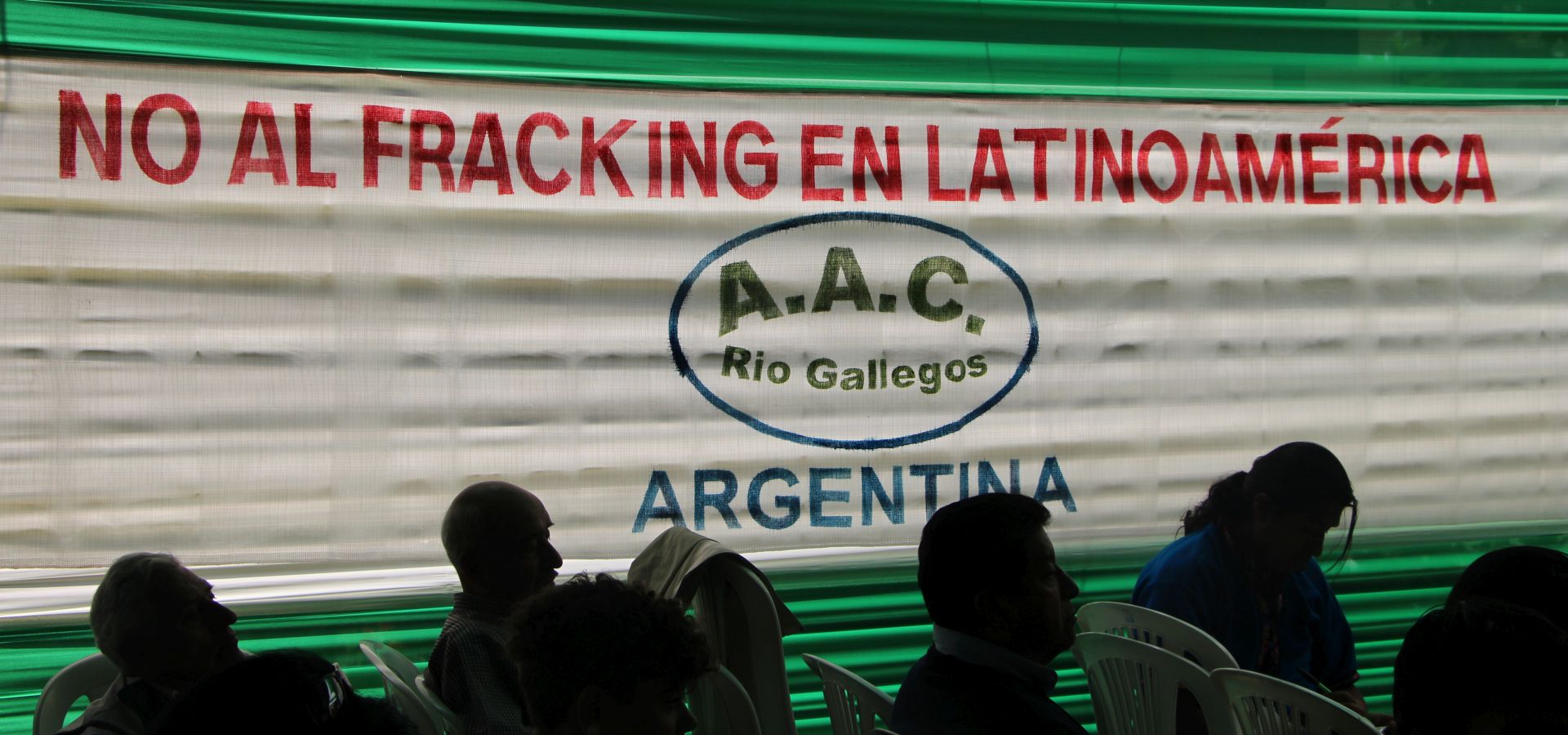Given the significance of securing water supply for human and non-human life, it is important to understand the potential devastating consequences that fracking has on the contamination and waste of water. Lillian Sol Cueva takes a look.

Argentina is considered the Latin American fracking capital number one. (Photo by Heinrich-Böll-Stiftung México, Centroamérica y el Caribe, modified, CC BY-SA 2.0)
Fracking is a method whereby hydrocarbons trapped within rocks are extracted. Fracking injects large quantities of water, sand and chemicals at high pressure into the ground to release the trapped shale oil and gas. Every well can use up to millions of gallons of water, making it necessary for large quantities of fresh water to be available. Most water used for fracking comes from surface water (i.e. from lakes and rivers). However, groundwater can be also used to increase surface water supplies.
According to the US. Geological Survey (USGS), it is impossible to determine a “fixed” amount of water used for fracking because it depends on issues, such as the rock formation, on whether the well is vertical or horizontal, on the number of stages of a given well (e.g. a horizontal wellbore may have 10 to 100 stages), and the operating body. However, based on the US and Canadian fracking average, we can assume that drilling a single well will require between 2 to 10 million gallons of water – enough to fill between 3 and 15 Olympic-sized swimming pools. In addition, this same study comes to the conclusion that water use in fracking has increased dramatically over the years; horizontal fracking operations in the US in particular are consuming more than 28 times the water they did 15 years ago.
After the fracking operation itself is finished, some of the contaminated fluids return to the surface. This wastewater consists of both flow-back and produced water. Flow-back refers to the water that returns to the surface after a hydraulic fracturing procedure is completed and pressure is released; produced water refers to the water that returns along with the extracted natural gas. Hundreds of billions of gallons of such wastewater – which is full of chemicals – are produced each year, and this massive amount of wastewater needs to go somewhere (usually it is managed through storage in disposal wells, deep injection and reuse). Disposal wells raise concerns about air quality and the risk of leaking or overflowing of the contaminated wastewater, which can lead to further groundwater and surface water pollution. The deep injection practice raises concerns about induced earthquakes. Until now, only about 15 per cent of the fracking wastewater is recycled due to high costs.
The state of Fracking in Latin America
We have reason to worry because fracking is expanding rapidly throughout Latin America. The U.S. Energy Information Administration (EIA) puts Argentina in second, Mexico in sixth and Brazil in tenth place in the world for technically recoverable shale gas reserves, based on its analysis of 42 countries.
Argentina is considered the Latin American fracking capital number one because of its numerous wells in the Neuquén Basin. This basin has more than 801.5 trillion cubic feet of wet shale gas, more than any country in the world aside from China. Just in 2015, the fracking technology was used in Argentina to drill into more than 1,000 shale gas reserves. In Mexico, meanwhile, almost one thousand wells are being fracked in 11 of the 32 Mexican states. In other Latin American countries, such as Bolivia, Colombia, Venezuela, Paraguay, Uruguay, Chile and Brazil, shale reserves have already been mapped out and initial exploration activities have begun.
As fracking is expanding in Latin America opposition to it is growing. In Brazil, organizations, researchers and activists are keeping up a constant fight against it. Last December, a federal Brazilian judge in the city of Cruzeiro do Sul, ordered the cancellation of all oil and gas exploration activities in the Amazon´s Jurúa Valley, including fracking. The judge’s decision was based on the social and environmental risks that these activities had had on the lives of the indigenous communities of the Juruá Valley (some of these communities are among the last fully remote tribes on earth) and the local ecosystems. In Mexico, the Mexican Alliance Against Fracking has carried out a number of activities under the campaign “Say no to fracking in Mexico!” A part of this campaign is a video where Mexican celebrities explain what fracking is and alert to its devastating consequences. In Argentina, several organizations have joined forces with the Cultural and Artistic Movement Against Fracking to appeal to the “precautionary principle” when it comes to fracking, i.e the need to prove that the technology is safe before engaging in it. Recently, a coalition of anti-fracking movements across Latin America called the Latin American Alliance Against Fracking has been set up to bundle anti fracking activities in international settings, such as the international climate negotiations.
One of the greatest concerns in Latin America is making sure clean water is available. In Argentina in particular, civil society is concerned about the risk of drilling into the Guaraní Aquifer, which would contaminate and destroy it. The Guarani aquifer is the largest groundwater resource in the world (45,000 km3 of water) that provides water to Argentina, Brazil, Paraguay and Uruguay. In Mexico, the discussion is about water and contamination conflicts that fracking causes with the agricultural sector. Here, more than 50 percent of all shale resources are in areas that are already experiencing severe water shortages (according to a recent study by the World Resources Institute).
In conclusion, the debate on fracking should not be limited to productivity and gains, but should include discussions on whether increased productivity could ultimately be a self-defeating prophecy when weighed against securing water supply, especially in already water stressed regions and highly vulnerable ecosystems.